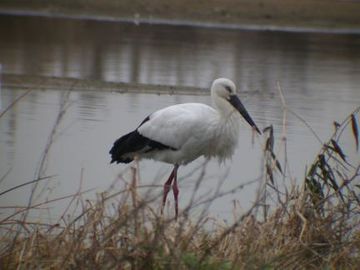황새
| 황새 Oriental White Stork (Ciconia boyciana) |
|
 황새, 국가문화유산포털, 문화재청. |
|
| 대표명칭 | 황새 |
|---|---|
| 영문명칭 | Oriental White Stork (Ciconia boyciana) |
| 지정(등록) 종목 | 천연기념물 제199호 |
| 지정(등록)일 | 1968년 6월 7일 |
| 분류 | 자연유산/천연기념물/생물과학기념물/진귀성 |
| 웹사이트 | 황새, 국가문화유산포털, 문화재청. |
해설문
국문
황새는 러시아의 시베리아, 중국의 동북부, 일본과 우리나라에 한정되어 분포하고 있으며, 겨울철에는 중국 동부와 우리나라 서·남부의 평야 지역에서 지낸다. 전 세계에 약 3,000 마리 정도만 남아 있는 것으로 알려진 국제 멸종 위기의 새이다.
몸 크기는 평균 112cm이고, 머리와 몸은 흰색이다. 눈 가장자리와 턱 밑의 붉은 피부는 밖으로 드러나 있다. 곧고 굵은 부리와 날개깃은 검은색이며 다리는 붉은색이다. 주로 습지에서 살며 어류, 곤충, 양서류, 파충류 등을 먹는다. 번식기가 되면 5~20m 높이의 나뭇가지 위에 큰 접시 모양으로 둥지를 틀고 알을 낳는다.
황새는 예부터 복을 가져다 주는 길조이자 마을의 수호신으로 알려져 있던 새로, 우리 문화와 연관이 깊고, 우리나라 각지에서 흔히 볼 수 있었던 텃새였다. 그러나 6·25 전쟁, 밀렵, 환경오염, 서식지 파괴 등으로 개체수가 급격하게 줄어들었다. 1971년에 충북 음성에서 마지막 암수 한 쌍 중 수컷이 죽고, 이후 1994년 마지막 암컷 황새가 죽은 후 텃새로서의 황새는 멸종되었다. 현재는 매년 11월~2월에 러시아나 중국으로부터 10~20마리가 철새로 날아온다.
한국교원대학교 황새생태연구원은 1996년부터 러시아, 일본, 독일에서 황새를 도입하여 개체 관리 및 인공 증식 연구 등에 힘쓰고 있다. 2015년 9월에는 예산 황새공원에서 황새의 첫 야생 복귀를 성공했다.
영문
Oriental White Stork (Ciconia boyciana)
The oriental white stork (Ciconia boyciana) is a large bird that was once common across Siberia, Northeast China, Japan, and Korea, tending to winter in Eastern China and the southwest of the Korean Peninsula. The species now has a very small, declining population of approximately 3,000 individuals and is classified as endangered species in many countries.
The bird measures 1.12 m on average from beak tip to end of tail and has white plumage on the head and body. It has patches of red skin around the eyes and under the chin, a thick and straight bill, black wings, and red legs. The bird inhabits wetlands, feeding on fish, insects, amphibians, and small reptiles. During breeding season, the bird builds its nest in the shape of a large dish on a tree branch 5-20 m above the ground.
In Korea, the oriental white stork had long been loved as an auspicious bird bringing fortune to the village where it was bred and even worshiped as a village guardian. It was deeply connected to Korean culture and was found almost everywhere across the country. Due to the Korean War (1950-1953) and the environmental disruption that destroyed its habitats, however, the population of the bird declined drastically in the second half of the 20th century. The species became extinct in Korea, when the male and female of the last bonded pair died in Eumseong, Chungcheongbuk-do Province in 1971 and 1994, respectively. Currently, some 10-20 oriental storks migrate to Korea from Russia or China to winter here from November to February.
In 1996, the Eco-Institute for Oriental White Stork at the Korean National University of Education imported bonded pairs from Russia and Germany to begin efforts to breed the storks for reintroduction to the wild. The first successful reintroduction took place in September 2015 at the Oriental White Stork Park in Yesan.
영문 해설 내용
황새는 러시아의 시베리아, 중국의 동북부, 일본, 한국에 한정되어 분포하고 있으며, 겨울철에는 중국 동부와 한반도 서·남부에서 지낸다. 전 세계에 약 3,000 마리 정도만 남아 있는 것으로 알려진 국제 멸종 위기의 새이다.
몸 크기는 평균 112cm이고, 머리와 몸은 흰색이다. 눈 가장자리와 턱 밑의 붉은 피부는 밖으로 드러나 있다. 곧고 굵은 부리와 날개깃은 검은색이며 다리는 붉은색이다. 주로 습지에서 살며 어류, 곤충, 양서류, 파충류 등을 먹는다. 번식기가 되면 5~20m 높이의 나뭇가지 위에 큰 접시 모양으로 둥지를 틀고 알을 낳는다.
황새는 예부터 복을 가져다 주는 길조이자 마을의 수호신으로 알려져 있던 새로, 한국의 문화와 연관이 깊고, 한반도 각지에서 흔히 볼 수 있었던 텃새였다. 그러나 한국전쟁과 서식지 파괴 등으로 20세기 후반 개체 수가 급격하게 줄어들었다. 1971년에 충북 음성에서 마지막 암수 한 쌍 중 수컷이 죽고, 이후 1994년 마지막 암컷 황새가 죽은 후 텃새로서의 황새는 멸종되었다. 현재는 매년 11월~2월에 러시아나 중국으로부터 10~20마리가 철새로 날아온다.
한국교원대학교 황새생태연구원은 1996년부터 러시아, 일본, 독일에서 황새를 도입하여 개체 관리 및 인공 증식 연구 등에 힘쓰고 있다. 2015년 9월에는 예산 황새공원에서 황새의 첫 야생 복귀를 성공했다.
참고자료
- 황새, 문화재청 국가문화유산포털. http://www.heritage.go.kr/heri/cul/culSelectDetail.do?pageNo=1_1_1_1&ccbaCpno=1369901990000#
- 황새, 한국민족문화대백과사전. http://encykorea.aks.ac.kr/Contents/SearchNavi?keyword=%ED%99%A9%EC%83%88&ridx=0&tot=12
- 황새, 한국향토문화전자대전. http://www.grandculture.net/ko/Contents/Index
- 문화재청, 『문화재대관 천연기념물·명승[동물] Ⅰ』, 문화재청 천연기념물과, 2009.